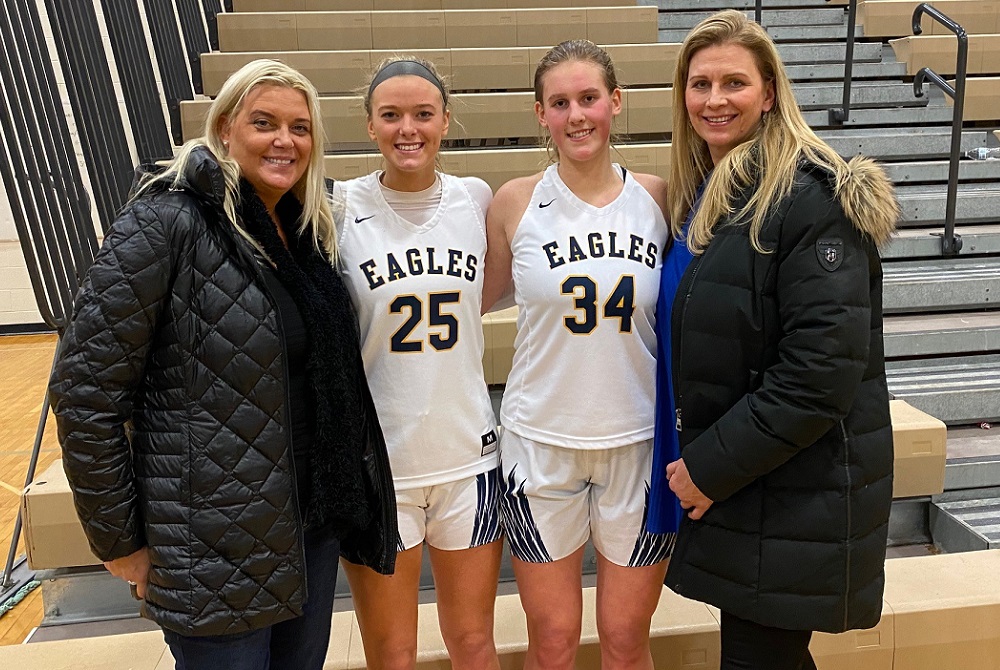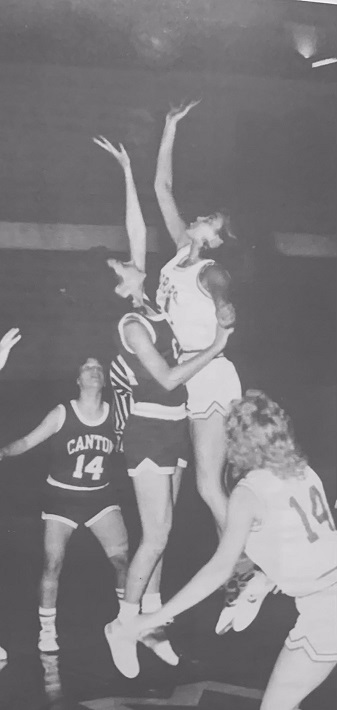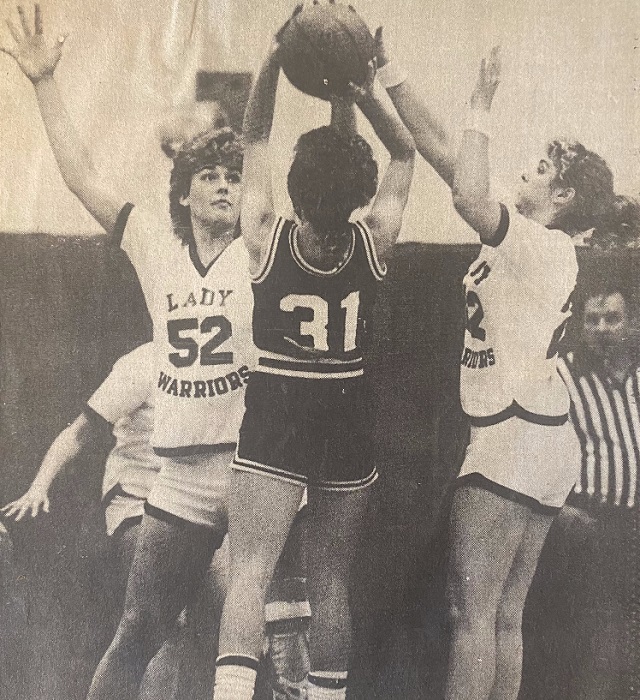
Hall Sisters' Daughters Giving Hartland Next-Generation Boost
By
Tim Robinson
Special for MHSAA.com
February 11, 2022
HARTLAND — Hartland girls basketball coach Don Palmer chuckles now when he talks about facing the Hall sisters 30 years ago, when they were at Walled Lake Western and he was at Milford.
 “I never could beat them,” he said, recalling facing Valerie, Dianne and Michelle Hall, all of them 6 feet tall or taller. “That in itself was a rarity, and they were so athletic. We played against the Halls when I had some of my best teams (at Milford). We never beat them, and they never cease to remind me of it.”
“I never could beat them,” he said, recalling facing Valerie, Dianne and Michelle Hall, all of them 6 feet tall or taller. “That in itself was a rarity, and they were so athletic. We played against the Halls when I had some of my best teams (at Milford). We never beat them, and they never cease to remind me of it.”
A little less than 20 years later, Val and Dianne and their families moved to Hartland about the time Palmer was taking over the Eagles program.
“Whitney was in the third or fourth grade,” Dianne Sollom recalled. “He was like, ‘Oh, the Hall girls! I could never beat you guys!’ And I said, ‘I have Whitney and another one coming in. They’ll be playing for you one day.’”
Whitney Sollom played four years for Palmer and is now a sophomore on the University of Michigan basketball team, a second-generation part of the program as Dianne also played for the Wolverines.
Whitney’s younger sister, Lauren, is a senior starter for the Eagles. One of her teammates is her cousin Sarah Rekowski, Val’s daughter.
“I played with my sister and now I’m playing with Sarah,” Lauren Sollom says. “I know my family is out there with me on the court going through the same thing I am. It’s very special to me.”
Lauren, who has signed to play at Saginaw Valley State, is a senior starter, while Sarah is a sophomore.
They are both from a college sports background. Lauren’s father, Ken, was a quarterback at Michigan and Sarah’s father, Stephen, was a defensive tackle for the Wolverines during the 1990s.
Dianne, who graduated from Western in 1989 and played basketball for Michigan State, met her husband when visiting Val at U-M.
“They grew up in it,” Dianne Sollom said. “If I’m not telling them, (Val) is telling them.”
Like their mothers, Lauren and Sarah are tall. Lauren is a 6-3 forward, while Sarah is a 6-2 post player for the Eagles.
Dianne says she’s 6 feet tall, “but I’m as tall as you want me to be,” she jokes. Val, a 1985 Western grad, was 6-4 in her playing days, as was their younger sister, Michelle.
Val played all four years at Michigan, and Dianne three years at Michigan State.
 “With my mom being a post player and my being a post, it helps me to know what to do in certain situations, and she gives me pointers,” Sarah said. "She’s always helping me with my game.”
“With my mom being a post player and my being a post, it helps me to know what to do in certain situations, and she gives me pointers,” Sarah said. "She’s always helping me with my game.”
But both moms have their limits.
“We do watch film together,” Val says of her time with Sarah, “but not a lot. I let Coach Palmer handle all that. I know Dianne and Ken have that ongoing conversation and try to help when they can. But you have to back off. A lot of the time they don’t want to hear you at all. You have to give them some time, that 24 hours or whatever.”
Sarah enjoys the physical portion of the game and showed her potential in the season opener, when she had 13 points and eight rebounds. Lauren will get inside for rebounds, but plays mostly on the perimeter, hoisting up 3-pointers, something Sarah hasn’t done yet.
“Coach Palmer has not given her the pass yet,” Lauren pronounced as both giggled.
“Coach Palmer would probably lose his mind,” Sarah said, grinning.
“He definitely would,’ Lauren said, to more laughter.
Sarah played on the JV team as a freshman last season, although her winter was interrupted by 10-day COVID-19 quarantines on a couple of occasions.
“She’s a little behind in her development,” Palmer said of Sarah, “but she really is a talented kid. She’s a big kid who, when she gets a rebound, it really is a rebound. We’re working on her constantly on her footwork.”
Sarah has been alternating with 6-4 senior Kate Jacobs in the post.
“It’s been up and down,” she says, “but I’ve gotten a lot of experience. I’m getting a decent amount of playing time.”
Lauren, meanwhile, is a team captain.
“Lauren’s a team-first player,” Palmer said. “She’s having a great year for us, she’s our leading scorer, leading rebounder and she’s having an MVP kind of year.
“They’re good kids,” Palmer said of the cousins. “They want to win, and they don’t care about how they do it. That’s the thing about this team. They’re all unselfish kids; you know, if they get 15 one night and get two the next and the team won both, they’re fine.”
In addition, Lauren’s fraternal twin brother, Brad, plays for the Hartland boys basketball team and will suit up at Concordia University in Ann Arbor next year, where he will play football.
For now, Lauren and Sarah are enjoying their year of varsity basketball together.
“We talk a lot,” Lauren said. “Basketball brings us together. Practices are fun, and I drive her to school in the morning and home in the evening. That’s good cousin time, family time.”
Speaking of family time, when Dianne (for MSU) and Michelle (U-M) played against each other in college, it was not unheard of for one sister to let the other have the occasional free lane to the basket, or for one to congratulate the other on a good shot while both were on the floor.
Once, castigated for complimenting her sister, Dianne said to her coach, “But she’s my sister!”
 Now, Dianne and Val sit in the stands at Hartland games, cheering their daughters on.
Now, Dianne and Val sit in the stands at Hartland games, cheering their daughters on.
“I enjoy watching her play,” Val said. “We’ve been watching Whitney and Lauren since they were young, and Sarah’s coming along. It’s fun to watch the light bulb come on and everything starts clicking. It’s really great when it all comes together for them.”
“I was on the court my entire life,” Dianne said. “I want to sit in the stands and watch my daughter and son. My husband is in the same boat. We’ve done it. We don’t have to shine.”
Hartland has been one of the top teams in the state this season, and the Eagles are looking toward a long run in the MHSAA Tournament, not unlike last year, when they reached the Division 1 quarterfinals.
To do so, the Eagles (14-1) are combining talent with togetherness, with nine seniors, including Lauren Sollom, looking out for themselves and a big sophomore in Sarah Rekowski who could play a key role down the stretch.
“She’s a very hard worker in practice and always has a smile on her face, even when Palmer is yelling at her,” said Lauren, joining her cousin with more giggles in a postgame interview, another shared moment in a season that already has produced memories for a lifetime and a special bond within a bond.
PHOTOS (Top) Dianne Sollom, far left, and Val Rekowski, far right, stand with daughters Lauren Sollom (25) and Sarah Rekowski (34) after a Hartland game. (Middle) Dianne Sollom, second-from-right, takes the opening jump against Canton while playing for Walled Lake Western. (Below) Val Hall (52) gets her hand on a shot while also starring for Walled Lake Western in this Novi-Walled Lake News clipping. (Top photo by Tim Robinson, middle and bottom photos provided by the Sollom and Rekowski families.)

Soccer, Hoops Next to Seed Using MPR
August 6, 2019
By Rob Kaminski
MHSAA benchmarks editor
As the topic of seeding for MHSAA Tournaments continues to swirl in the air of numerous committee meetings on an annual basis, one of the primary concerns continues to focus on the simple question: “How?”
The MHSAA for years has been working behind the scenes on potential formulas which could best be used as a standardized tool to assist in measuring strengths of teams in a given sport.
This spring, the MHSAA introduced the Michigan Power Rating in the sport of Boys Lacrosse. The Representative Council approved limited seeding beginning in 2019-20 for girls and boys soccer and girls and boys basketball, and MPR will be the metric to determine which two teams must be seeded on opposite sides of District brackets in those sports.
“The boys lacrosse tournament has been seeded since it was added as an MHSAA-sponsored sport in 2005. The seeding is done by committee based on several criteria, one of which was statewide power rankings generated by a third-party website. In the Fall of 2018, that website ceased operation – it was the perfect opportunity for the MHSAA to develop its own data-driven, purely objective ratings system and incorporate that data into the seeding criteria,” said Cole Malatinsky, administrative assistant for the sport.
“The benefits of the new MPR system have been already mentioned – it is MHSAA controlled, simple, objective, and transparent, and it can be used by other MHSAA sports in the future.”
MPR is a computer rating formula similar to the popular RPI rating. MPR provides a way to measure a team’s strength relative to other teams, based on games played against other MHSAA tournament teams, largely on the strength of their opponents’ schedules. MPR is purely objective using only the game results listed on MHSAA.com – there is no subjective human element.
What is the basic MPR formula?
MPR is calculated using wins, losses and ties for games played between teams entered into the MHSAA tournament. The final MPR number is 25% of the team's winning percentage, plus 50% of its opponent's winning percentage, plus 25% of its opponent's opponent's winning percentage.
MPR = (.25 x W%) + (.50 x OW%) + (.25 x OOW%)
The MPR formula can be applied easily to other MHSAA team sports.
What game data is included in the formula? What game data is not?
MPR looks only at results between opponents entered into the MHSAA postseason tournament. Wins, losses and ties in multi-team shortened game tournaments (lacrosse, soccer) also count. Forfeits also are counted as wins and losses.
MPR does not use the specific scores of a game or the margin of victory in a game. The location of a game is not included in the MPR formula, and the formula weighs results at the beginning of the season the same as results at the end of the season. Scrimmages are not included.
Why use the MPR formula?
Different rating systems have been used in the past or have been recommended to the MHSAA. We wanted to have a rating system where the data was controlled and stored in house and could be used for any sport featuring head-to-head competitions.
With its own rating system the MHSAA also can control the different components of the formula, thus keeping the tenets of scholastic competition at the forefront (like not including margin of victory in the formula). Finally, by listing all scores and team schedules online, as well as showing the MPR calculator on each team schedule page, the ratings are transparent and can be replicated easily.
CALCULATING MPR
What are the detailed components of the MPR formula?
You need three numbers to calculate your MPR: winning percentage (W%), opponent’s winning percentage (OW%) and opponent’s opponent’s winning percentage (OOW%).
How do you calculate winning percentage (W%)?
Divide the number of wins by the number of total games played. A tie is worth half a win. For MPR purposes, find the winning percentage against all teams that will play in the MHSAA tournament (MPR W%). Games played against out-of-state teams, varsity “B” teams, junior varsity teams, non-school club teams, and any other non-MHSAA tournament participants should not be included when calculating winning percentage. W% should be an easy number to calculate.
How do you calculate opponent’s winning percentage (OW%)?
Average the winning percentages of a team's opponents. When calculating the winning percentage of a specific opponent, use the opponents "Adjusted Winning Percentage" (ADJ W%). Adjusted winning percentage eliminates all games the team played against that opponent (as well as its games against non-MHSAA opponents).
For instance, if the team beat an opponent with an overall record of 4-1, use a record of 4-0 (1.000) for that opponent. If the team lost to an opponent, use a record of 3-1 (.750). Find the ADJ W% for all opponents, and then take the average. If a team plays an opponent team twice, that opponent’s ADJ W% will be counted twice.
OW% is not calculated via the combined record of the opponents; instead take the average of all opponent’s winning percentages.
How do you calculate opponent’s opponent’s winning percentage (OOW%)?
Use the same process described above, except calculated for the opponents of a team's opponents. This number is much harder to manually calculate, so the OW% for every team is listed on the MPR page of the MHSAA website.
Again, simply take the average of all opponent’s OW%.
How often is MPR calculated?
MPR is calculated about every five minutes. Enter a score and a minutes later the team MPR and the MPR of all the team's opponents will update.
How much will my MPR change throughout the season?
You will see wild MPR swings in the beginning of the season, but after about 10 games played your MPR will start to level out. At 20 games played you will see very little movement with each additional game played.
My score is missing. How can it be added?
This is a crowd-sourced system. Any registered user of MHSAA.com can add a missing score. ADs, coaches, parents, students and fans all can login and enter a score for any game.
What are some common errors when calculating MPR?
When calculating your team’s winning percentage, only include games against MHSAA-tournament teams. When calculating your opponent’s winning percentage, don’t include the games they played against you. When calculating ties, count the game as a half-win and half-loss.
What happens if a game is cancelled?
Because the MPR system works off of averages, it will not make a difference in the final MPR if a game cannot be rescheduled. It would not penalize, nor benefit, any team involved in that scenario.
USING THE WEBSITE
Where can I find game scores?
A list of statewide scores for all sports can be found in the MHSAA Score Center. To find a schedule for any team click on “Schools & Schedules” in the top navigation bar, search for the school, then once on the school page click the sport. You can also see a list of all schools (with links to schedules), on the statewide MPR list.
“We continue to have great success in score reporting for varsity boys lacrosse contests. While we state that schedule submission and score reporting to MHSAA.com are required, athletic directors and coaches understand that in order for MPR data to be accurate, we need consistent and accurate score reporting,” said Malatinsky. “MHSAA.com is now the primary site for high school boys lacrosse schedules, results and ratings in the state.”
How should I use the statewide list of teams and MPR?
Linked to the boys soccer page (and eventually to be added for both basketball pages and girls soccer) is a statewide listing of all Michigan Power Ratings (MPR) for teams entered into the MHSAA postseason tournament for that sport. Linked on the MPR page is an explanation of the District draw formula, describing when and how teams will be placed on the bracket.
The MPR data updates every five minutes. Click on the column headings to sort the data. You also can use the drop-down menu to show teams in one Division, or type a District number in the box to filter teams for that District (Region for boys lacrosse).
You also can click on any school name to go to its schedule page.
How do I read the school schedule page?
The schedule at the top of the page shows the date and opponent for all scheduled games, and results for games already played. If results are missing, click “Submit Score” to add a game score.
Below the game schedule is the MPR Calculator. The calculator is split into three sections. The first section shows the three MPR component scores for the team, as well as the team’s current MPR score. The second section shows the MPR information for the team’s opponents – specifically, for the opponents the team already has played (actually, for games where scores have been submitted). Only these games are included in the MPR calculation.
The third section highlights future opponents. The MPR data for future opponents are not used in the MPR calculation for the team.
PHOTO: East Kentwood and Ann Arbor Skyline play for last season’s Division 1 boys soccer championship.

